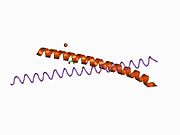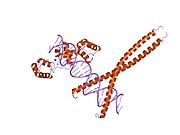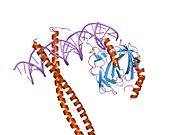CCAAT/enhancer-binding protein beta is a protein that in humans is encoded by the CEBPB gene.
Function
The protein encoded by this intronless gene is a bZIP transcription factor that can bind as a homodimer to certain DNA regulatory regions. It can also form heterodimers with the related proteins CEBP-alpha, CEBP-delta, and CEBP-gamma. The encoded protein is important in the regulation of genes involved in immune and inflammatory responses and has been shown to bind to the IL-1 response element in the IL-6 gene, as well as to regulatory regions of several acute-phase and cytokine genes. In addition, the encoded protein can bind the promoter and upstream element and stimulate the expression of the collagen type I gene.
CEBP-beta is critical for normal macrophage functioning, an important immune cell sub-type; mice unable to express CEBP-beta have macrophages that cannot differentiate (specialize) and thus are unable to perform all their biological functions—including macrophage-mediated muscle repair. Observational work has shown that expression of CEBP-beta in blood leukocytes is positively associated with muscle strength in humans, emphasizing the importance of the immune system, and particularly macrophages, in the maintenance of muscle function.
Function of CEBPB gene can be effectively examined by siRNA knockdown based on an independent validation.
Upon further investigation, it was noted that CEBPB has close to 8,600 similar correlations with biological manipulations ranging from molecules to proteins or abstracted microRNAs. This protein is found in blood and is upregulated in diseases by acute myeloid leukemia, Glioma, and prostate cancer. This idea is predicated in an intracellular location and precisely localized to the nucleoplasm.
Target genes
CEBPB is capable of increasing the expression of several target genes. Among them, some have specific role in the nervous system such as the preprotachykinin-1 gene, giving rise to substance P and neurokinin A and the choline acetyltransferase responsible for the biosynthesis of the important neurotransmitter acetylcholine. Other targets include genes coding for cytokines such as IL-6, IL-4, IL-5, and TNF-alpha. Genes coding for transporter proteins that confer multidrug resistance to the cells have also been found to be activated by CEBPB. Such genes include ABCC2 and ABCB1.
Enhancer Binding-Protein
The CEBPB gene encodes a transcription factor. As previously mentioned, "It contains a leucine zipper (bZIP) domain and the encoded protein functions as a homodimer. It can also form heterodimers with enhancer-binding proteins such as alpha, delta, and gamma. The activity of this protein is important in regulating genes involving the immune and inflammatory responses, among other processes. The "AUG" start codons, resulting in multiple protein isoforms". It was also mentioned that each of these codon has a different biological function in the body.
This pathway allows for proliferation, inhibition, and even survival. This gene is a vital part of proliferation and segregation. It's important "as the transcription factor regulates the expression of genes that are involved in the immune and inflammatory response, it includes the gluconeogenic pathway and liver recovery. It has a probiotic effect on many cell types, like hepatocytes and adipocytes. However, it exerts differential "effects on T cells by inhibiting MYC expression and promoting differentiation of the T helper lineage." It binds to the regulatory regions of several phase and cytokine genes".
Cancer
CEBPB is a type of CEBP transcript. CEBPB gene is noted in macrophages in SKCM and provides a favorable prognosis with metastatic cancer by being a biomarker for the patient's diagnosis stratification. Through integrated analysis of single-cell and bulk RNA-sequence datasets. Since CEBPB is a transcription factor in regulating gene expression, patients with metastatic melanoma may benefit long-term by blocking proteins such as CTLA-4 Other. Any other pathway of immune activation, such as targeting CEBPB. It is widely expressed in several different cancers.
Interactions
CEBPB has been shown to interact with:
- CREB1,
- CRSP3
- DNA damage-inducible transcript 3,
- EP300,
- Estrogen receptor alpha,
- Glucocorticoid receptor,
- HMGA1,
- HSF1,
- Nucleolar phosphoprotein p130,
- RELA,
- Serum response factor,
- SMARCA2,
- Sp1 transcription factor,
- TRIM28, and
- Zif268.
See also
References
- ^ GRCh38: Ensembl release 89: ENSG00000172216 – Ensembl, May 2017
- ^ GRCm38: Ensembl release 89: ENSMUSG00000056501 – Ensembl, May 2017
- "Human PubMed Reference:". National Center for Biotechnology Information, U.S. National Library of Medicine.
- "Mouse PubMed Reference:". National Center for Biotechnology Information, U.S. National Library of Medicine.
- Szpirer C, Riviere M, Cortese R, Nakamura T, Islam MQ, Levan G, Szpirer J (June 1992). "Chromosomal localization in man and rat of the genes encoding the liver-enriched transcription factors C/EBP, DBP, and HNF1/LFB-1 (CEBP, DBP, and transcription factor 1, TCF1, respectively) and of the hepatocyte growth factor/scatter factor gene (HGF)". Genomics. 13 (2): 293–300. doi:10.1016/0888-7543(92)90245-N. PMID 1535333.
- Cao Z, Umek RM, McKnight SL (September 1991). "Regulated expression of three C/EBP isoforms during adipose conversion of 3T3-L1 cells". Genes & Development. 5 (9): 1538–1552. doi:10.1101/gad.5.9.1538. PMID 1840554.
- "Entrez Gene: CEBPB CCAAT/enhancer binding protein (C/EBP), beta".
- Ruffell D, Mourkioti F, Gambardella A, Kirstetter P, Lopez RG, Rosenthal N, Nerlov C (October 2009). "A CREB-C/EBPbeta cascade induces M2 macrophage-specific gene expression and promotes muscle injury repair". Proceedings of the National Academy of Sciences of the United States of America. 106 (41): 17475–17480. Bibcode:2009PNAS..10617475R. doi:10.1073/pnas.0908641106. PMC 2762675. PMID 19805133.
- Harries LW, Pilling LC, Hernandez LD, Bradley-Smith R, Henley W, Singleton AB, et al. (April 2012). "CCAAT-enhancer-binding protein-beta expression in vivo is associated with muscle strength". Aging Cell. 11 (2): 262–268. doi:10.1111/j.1474-9726.2011.00782.x. PMC 3486692. PMID 22152057.
- Munkácsy G, Sztupinszki Z, Herman P, Bán B, Pénzváltó Z, Szarvas N, Győrffy B (September 2016). "Validation of RNAi Silencing Efficiency Using Gene Array Data shows 18.5% Failure Rate across 429 Independent Experiments". Molecular Therapy. Nucleic Acids. 5 (9): e366. doi:10.1038/mtna.2016.66. PMC 5056990. PMID 27673562.
- Kovács KA, Steinmann M, Magistretti PJ, Halfon O, Cardinaux JR (September 2006). "C/EBPbeta couples dopamine signalling to substance P precursor gene expression in striatal neurones". Journal of Neurochemistry. 98 (5): 1390–1399. doi:10.1111/j.1471-4159.2006.03957.x. PMID 16771829. S2CID 36225447.
- Robert I, Sutter A, Quirin-Stricker C (October 2002). "Synergistic activation of the human choline acetyltransferase gene by c-Myb and C/EBPbeta". Brain Research. Molecular Brain Research. 106 (1–2): 124–135. doi:10.1016/S0169-328X(02)00419-9. PMID 12393272.
- Natsuka S, Akira S, Nishio Y, Hashimoto S, Sugita T, Isshiki H, Kishimoto T (January 1992). "Macrophage differentiation-specific expression of NF-IL6, a transcription factor for interleukin-6". Blood. 79 (2): 460–466. doi:10.1182/blood.V79.2.460.460. PMID 1730090.
- Davydov IV, Krammer PH, Li-Weber M (December 1995). "Nuclear factor-IL6 activates the human IL-4 promoter in T cells". Journal of Immunology. 155 (11): 5273–5279. doi:10.4049/jimmunol.155.11.5273. PMID 7594540. S2CID 22681826.
- van Dijk TB, Baltus B, Raaijmakers JA, Lammers JW, Koenderman L, de Groot RP (September 1999). "A composite C/EBP binding site is essential for the activity of the promoter of the IL-3/IL-5/granulocyte-macrophage colony-stimulating factor receptor beta c gene". Journal of Immunology. 163 (5): 2674–2680. doi:10.4049/jimmunol.163.5.2674. PMID 10453008. S2CID 45357917.
- Greenwel P, Tanaka S, Penkov D, Zhang W, Olive M, Moll J, et al. (February 2000). "Tumor necrosis factor alpha inhibits type I collagen synthesis through repressive CCAAT/enhancer-binding proteins". Molecular and Cellular Biology. 20 (3): 912–918. doi:10.1128/MCB.20.3.912-918.2000. PMC 85208. PMID 10629048.
- Tanaka T, Uchiumi T, Hinoshita E, Inokuchi A, Toh S, Wada M, et al. (December 1999). "The human multidrug resistance protein 2 gene: functional characterization of the 5'-flanking region and expression in hepatic cells". Hepatology. 30 (6): 1507–1512. doi:10.1002/hep.510300617. PMID 10573531. S2CID 22514353.
- Chen KG, Sale S, Tan T, Ermoian RP, Sikic BI (April 2004). "CCAAT/enhancer-binding protein beta (nuclear factor for interleukin 6) transactivates the human MDR1 gene by interaction with an inverted CCAAT box in human cancer cells". Molecular Pharmacology. 65 (4): 906–916. doi:10.1124/mol.65.4.906. PMID 15044620. S2CID 86591291.
- "CEBPB protein expression summary - The Human Protein Atlas". www.proteinatlas.org. Retrieved 2023-05-16.
- "Gene - CEBPB". maayanlab.cloud. Retrieved 2023-05-16.
- "CEBPB CCAAT enhancer binding protein beta [Homo sapiens (human)] - Gene - NCBI". www.ncbi.nlm.nih.gov. Retrieved 2023-05-16.
- Chen Y, Zhuang S, Cassenaer S, Casteel DE, Gudi T, Boss GR, Pilz RB (June 2003). "Synergism between calcium and cyclic GMP in cyclic AMP response element-dependent transcriptional regulation requires cooperation between CREB and C/EBP-beta". Molecular and Cellular Biology. 23 (12): 4066–4082. doi:10.1128/mcb.23.12.4066-4082.2003. PMC 156132. PMID 12773552.
- Mo X, Kowenz-Leutz E, Xu H, Leutz A (January 2004). "Ras induces mediator complex exchange on C/EBP beta". Molecular Cell. 13 (2): 241–250. doi:10.1016/s1097-2765(03)00521-5. PMID 14759369.
- Hattori T, Ohoka N, Hayashi H, Onozaki K (April 2003). "C/EBP homologous protein (CHOP) up-regulates IL-6 transcription by trapping negative regulating NF-IL6 isoform". FEBS Letters. 541 (1–3): 33–39. Bibcode:2003FEBSL.541...33H. doi:10.1016/s0014-5793(03)00283-7. PMID 12706815. S2CID 43792576.
- Fawcett TW, Eastman HB, Martindale JL, Holbrook NJ (June 1996). "Physical and functional association between GADD153 and CCAAT/enhancer-binding protein beta during cellular stress". The Journal of Biological Chemistry. 271 (24): 14285–14289. doi:10.1074/jbc.271.24.14285. PMID 8662954.
- Mink S, Haenig B, Klempnauer KH (November 1997). "Interaction and functional collaboration of p300 and C/EBPbeta". Molecular and Cellular Biology. 17 (11): 6609–6617. doi:10.1128/mcb.17.11.6609. PMC 232514. PMID 9343424.
- ^ Boruk M, Savory JG, Haché RJ (November 1998). "AF-2-dependent potentiation of CCAAT enhancer binding protein beta-mediated transcriptional activation by glucocorticoid receptor". Molecular Endocrinology. 12 (11): 1749–1763. doi:10.1210/mend.12.11.0191. PMID 9817600.
- Stein B, Yang MX (September 1995). "Repression of the interleukin-6 promoter by estrogen receptor is mediated by NF-kappa B and C/EBP beta". Molecular and Cellular Biology. 15 (9): 4971–4979. doi:10.1128/mcb.15.9.4971. PMC 230744. PMID 7651415.
- ^ Foti D, Iuliano R, Chiefari E, Brunetti A (April 2003). "A nucleoprotein complex containing Sp1, C/EBP beta, and HMGI-Y controls human insulin receptor gene transcription". Molecular and Cellular Biology. 23 (8): 2720–2732. doi:10.1128/mcb.23.8.2720-2732.2003. PMC 152545. PMID 12665574.
- Xie Y, Chen C, Stevenson MA, Auron PE, Calderwood SK (April 2002). "Heat shock factor 1 represses transcription of the IL-1beta gene through physical interaction with the nuclear factor of interleukin 6". The Journal of Biological Chemistry. 277 (14): 11802–11810. doi:10.1074/jbc.M109296200. PMID 11801594.
- Miau LH, Chang CJ, Shen BJ, Tsai WH, Lee SC (April 1998). "Identification of heterogeneous nuclear ribonucleoprotein K (hnRNP K) as a repressor of C/EBPbeta-mediated gene activation". The Journal of Biological Chemistry. 273 (17): 10784–10791. doi:10.1074/jbc.273.17.10784. PMID 9553145.
- Weber M, Sydlik C, Quirling M, Nothdurfter C, Zwergal A, Heiss P, et al. (June 2003). "Transcriptional inhibition of interleukin-8 expression in tumor necrosis factor-tolerant cells: evidence for involvement of C/EBP beta". The Journal of Biological Chemistry. 278 (26): 23586–23593. doi:10.1074/jbc.M211646200. PMID 12707271.
- Xia C, Cheshire JK, Patel H, Woo P (December 1997). "Cross-talk between transcription factors NF-kappa B and C/EBP in the transcriptional regulation of genes". The International Journal of Biochemistry & Cell Biology. 29 (12): 1525–1539. doi:10.1016/s1357-2725(97)00083-6. PMID 9570146.
- Hanlon M, Sealy L (May 1999). "Ras regulates the association of serum response factor and CCAAT/enhancer-binding protein beta". The Journal of Biological Chemistry. 274 (20): 14224–14228. doi:10.1074/jbc.274.20.14224. PMID 10318842.
- Sealy L, Malone D, Pawlak M (March 1997). "Regulation of the cfos serum response element by C/EBPbeta". Molecular and Cellular Biology. 17 (3): 1744–1755. doi:10.1128/mcb.17.3.1744. PMC 231899. PMID 9032301.
- Kowenz-Leutz E, Leutz A (November 1999). "A C/EBP beta isoform recruits the SWI/SNF complex to activate myeloid genes". Molecular Cell. 4 (5): 735–743. doi:10.1016/s1097-2765(00)80384-6. PMID 10619021.
- Liu YW, Tseng HP, Chen LC, Chen BK, Chang WC (July 2003). "Functional cooperation of simian virus 40 promoter factor 1 and CCAAT/enhancer-binding protein beta and delta in lipopolysaccharide-induced gene activation of IL-10 in mouse macrophages". Journal of Immunology. 171 (2): 821–828. doi:10.4049/jimmunol.171.2.821. PMID 12847250.
- Rooney JW, Calame KL (November 2001). "TIF1beta functions as a coactivator for C/EBPbeta and is required for induced differentiation in the myelomonocytic cell line U937". Genes & Development. 15 (22): 3023–3038. doi:10.1101/gad.937201. PMC 312827. PMID 11711437. (Retracted, see Error: Bad DOI specified!, PMID 12269264, Retraction Watch)
- Chang CJ, Chen YL, Lee SC (October 1998). "Coactivator TIF1beta interacts with transcription factor C/EBPbeta and glucocorticoid receptor to induce alpha1-acid glycoprotein gene expression". Molecular and Cellular Biology. 18 (10): 5880–5887. doi:10.1128/mcb.18.10.5880. PMC 109174. PMID 9742105.
- Zhang F, Lin M, Abidi P, Thiel G, Liu J (November 2003). "Specific interaction of Egr1 and c/EBPbeta leads to the transcriptional activation of the human low density lipoprotein receptor gene". The Journal of Biological Chemistry. 278 (45): 44246–44254. doi:10.1074/jbc.M305564200. PMID 12947119.
External links
- Human CEBPB genome location and CEBPB gene details page in the UCSC Genome Browser.
- CEBPB+protein,+human at the U.S. National Library of Medicine Medical Subject Headings (MeSH)
- FactorBook CEBPB
This article incorporates text from the United States National Library of Medicine, which is in the public domain.
| PDB gallery | |
|---|---|
|
| Transcription factors and intracellular receptors | |||||||||||||||||||||||||||||||
|---|---|---|---|---|---|---|---|---|---|---|---|---|---|---|---|---|---|---|---|---|---|---|---|---|---|---|---|---|---|---|---|
| |||||||||||||||||||||||||||||||
| |||||||||||||||||||||||||||||||
| |||||||||||||||||||||||||||||||
| |||||||||||||||||||||||||||||||
| |||||||||||||||||||||||||||||||
| see also transcription factor/coregulator deficiencies | |||||||||||||||||||||||||||||||














